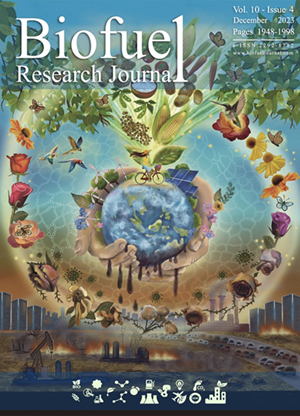Effects of particle size of cerium oxide nanoparticles on the combustion behavior and exhaust emissions of a diesel engine powered by biodiesel/diesel blend
IF 11.9
Q1 ENERGY & FUELS
引用次数: 26
Abstract
Meeting the emission norms specified by governing bodies is one of the major challenges faced by engine manufacturers, especially without sacrificing engine performance and fuel economy. Several methods and techniques are being used globally to reduce engine emissions. Even though emissions can be reduced, doing so usually entails a deterioration in performance. To address this problem, nanoadditives such as cerium oxide (CeO2) nanoparticles are used to reduce engine emissions while improving engine performance. However, some aspects of the application of these nanoadditives are still unknown. In light of that, three sizes of CeO2 nanoparticles (i.e., 10, 30, and 80 nm) and at a constant volume fraction of 80 ppm were added to a 20% blend of waste cooking oil biodiesel and diesel (B20). A single-cylinder diesel engine operating at a 1500 rpm speed and 180 bar fuel injection pressure was used to compare the performance and emission characteristics of the investigated fuel formulations. The results showed that the addition of CeO2 nanoparticles led to performance improvements by reducing brake specific fuel consumption. Moreover, the catalytic action of CeO2 nanoparticles on the hydrocarbons helped achieve effective combustion and reduce the emission of carbon monoxide, unburnt hydrocarbon, oxides of nitrogen, and soot. Interestingly, the size of the nanoadditive played an instrumental role in the improvements achieved, and the use of 30 nm-sized nanoparticles led to the most favorable performance and the lowest engine emissions. More specifically, the fuel formulation harboring 30 nm nanoceria reduced brake specific fuel consumption by 2.5%, NOx emission by 15.7%, and smoke opacity by 34.7%, compared to the additive-free B20. These findings could shed light on the action mechanism of fuel nanoadditives and are expected to pave the way for future research to develop more promising fuel nanoadditives for commercial applications.纳米氧化铈颗粒尺寸对生物柴油/柴油混合动力柴油机燃烧行为和废气排放的影响
满足管理机构规定的排放标准是发动机制造商面临的主要挑战之一,尤其是在不牺牲发动机性能和燃油经济性的情况下。全球正在使用几种方法和技术来减少发动机排放。尽管排放量可以减少,但这样做通常会导致性能下降。为了解决这个问题,纳米添加剂如氧化铈(CeO2)纳米颗粒被用于减少发动机排放,同时提高发动机性能。然而,这些纳米添加剂应用的某些方面仍然未知。有鉴于此,将三种尺寸的CeO2纳米颗粒(即,10、30和80nm)和80ppm的恒定体积分数添加到废食用油生物柴油和柴油(B20)的20%混合物中。使用在1500rpm转速和180bar燃料喷射压力下运行的单缸柴油发动机来比较所研究的燃料配方的性能和排放特性。结果表明,CeO2纳米颗粒的加入降低了制动器的比油耗,从而提高了性能。此外,CeO2纳米颗粒对碳氢化合物的催化作用有助于实现有效燃烧,并减少一氧化碳、未燃烧碳氢化合物、氮氧化物和烟灰的排放。有趣的是,纳米添加剂的尺寸在所实现的改进中发挥了重要作用,使用30nm尺寸的纳米颗粒可以获得最有利的性能和最低的发动机排放。更具体地说,与不含添加剂的B20相比,含有30nm纳米二氧化铈的燃料配方降低了2.5%的制动比燃料消耗、15.7%的NOx排放和34.7%的烟雾不透明度。这些发现可能揭示燃料纳米添加剂的作用机制,并有望为未来研究开发更具商业应用前景的燃料纳米添加剂铺平道路。
本文章由计算机程序翻译,如有差异,请以英文原文为准。
求助全文
约1分钟内获得全文
求助全文
来源期刊

Biofuel Research Journal-BRJ
ENERGY & FUELS-
CiteScore
22.10
自引率
1.50%
发文量
15
审稿时长
8 weeks
期刊介绍:
Biofuel Research Journal (BRJ) is a leading, peer-reviewed academic journal that focuses on high-quality research in the field of biofuels, bioproducts, and biomass-derived materials and technologies. The journal's primary goal is to contribute to the advancement of knowledge and understanding in the areas of sustainable energy solutions, environmental protection, and the circular economy. BRJ accepts various types of articles, including original research papers, review papers, case studies, short communications, and hypotheses. The specific areas covered by the journal include Biofuels and Bioproducts, Biomass Valorization, Biomass-Derived Materials for Energy and Storage Systems, Techno-Economic and Environmental Assessments, Climate Change and Sustainability, and Biofuels and Bioproducts in Circular Economy, among others. BRJ actively encourages interdisciplinary collaborations among researchers, engineers, scientists, policymakers, and industry experts to facilitate the adoption of sustainable energy solutions and promote a greener future. The journal maintains rigorous standards of peer review and editorial integrity to ensure that only impactful and high-quality research is published. Currently, BRJ is indexed by several prominent databases such as Web of Science, CAS Databases, Directory of Open Access Journals, Scimago Journal Rank, Scopus, Google Scholar, Elektronische Zeitschriftenbibliothek EZB, et al.
 求助内容:
求助内容: 应助结果提醒方式:
应助结果提醒方式:


